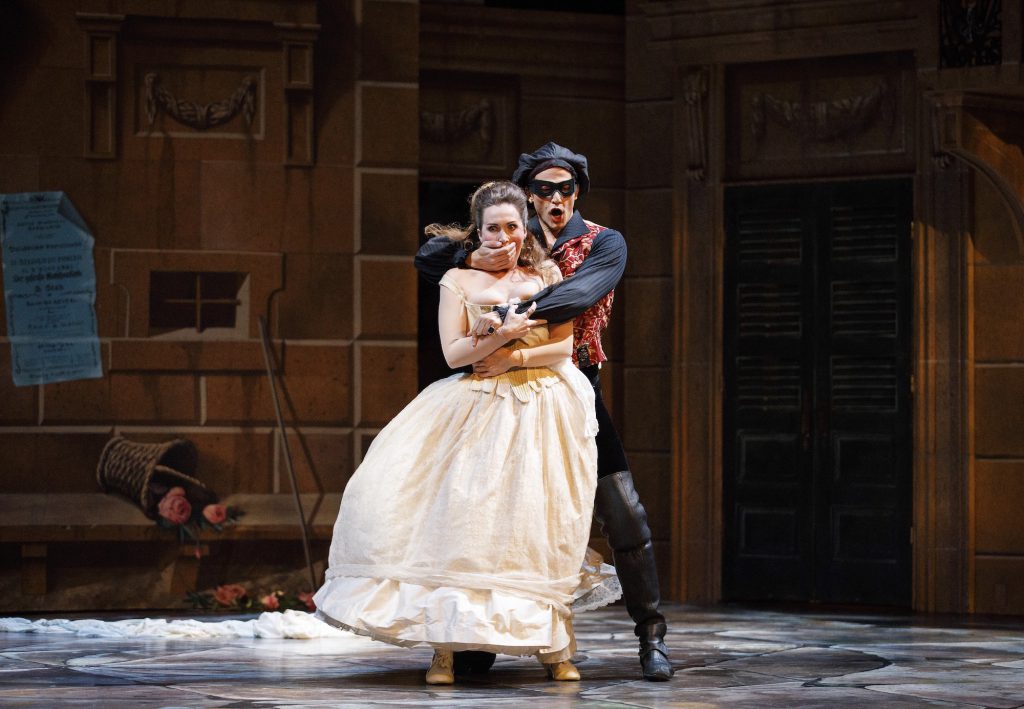Style is not the target. It is what we use to take aim. — Jean Cocteau
The quote, characteristically invoked by early opera director Marshall Pynkoski in interviews, is a favourite, a pithy aphorism that manages to encapsulate the entire sweep of his broad, historically based aesthetic. Honed and refined over a period of almost three and a half decades, Pynkoski and Opera Atelier co-artistic director Jeannette Lajeunesse Zingg, have evolved a distinctively pointed sensibility, a vibrant, dynamic approach to the Baroque bursting with passion. Tumultuous 18th century music drama shares the spotlight with cutting edge 21st century production values. The product of the strategy, the striking visualization of timeless human emotion, is a potent weapon in Pynkoski’s theatrical arsenal.
Raising the curtain at the Ed Mirvish Theatre, Opera Atelier sets its sights on its current offering, a spectacular remount of the company’s 2011 Don Giovanni, zeroing in on the perverse, uniquely expressive black comedy that lies beneath the tangle of commedia dell’arte farce that overlays the piece.
The need to squeeze Don Giovanni into some sort of impossibly narrow niche has obsessed critics virtually from the moment the iconic work premiered in 1787. There has been little consensus. Even its creators had different perspectives when confronting the issue of genre. Librettist Lorenzo Da Ponte, a decidedly cynical observer of the human condition, regarded his dissolute tale of debauchery and damnation as dramma giocoso (a drama with jokes). Mozart, ever the eager popular entertainer, reversed the emphasis characterizing his rather more buoyant contribution to the project as opera buffa (comic opera). Social treatise: classes in conflict. Gothic melodrama: evil unleashed. Psychological thriller: id vs. ego. The continuing discourse continues.
Opera Atelier makes no secret of Pynkoski’s impatience with the endless debate. Showcasing an enlarged fragment of text written in Mozart’s hand extracted from the composer’s manuscript score, conspicuously circled in red, the program cover shouts, opera Buffa in 2 Atti. The artistic self-confidence on show here is considerably less than restrained. This will be a diverting Don Giovanni in the classic tradition, we are promised, all chaos and conflict and riotous exploits. Nothing that follows throughout the evening disappoints. The brilliance of Da Ponte’s wry, razor sharp language, the zip and sparkle of Mozart’s music — every second of genius is celebrated.
Pynkoski’s unwavering focus on the overtly comedic releases much of the pent up pressure long associated with this, the second and arguably densest entry in the Mozart/Da Ponte catalogue. Far darker than The Marriage of Figaro, infinitely less forgiving than Così fan tutte, Don Giovanni largely functions as a discrete work. Textually blunt, often violent, the philandering aristocrat at the centre of the tale presents something of an enduring puzzle. For all of Don Giovanni’s celebrated prowess as a tireless seducer — mercenary retainer, Leporello, meticulously keeps score — the slippery nobleman proves remarkably inept at securing new conquests after curtain rise. Onset impotence, some commentators have suggested. Or self-loathing. Or ennui.
Pynkoski ignores yet another round of speculation and drives the opera forward. Action unfolds in a continuum, characters colliding, story leaping story scene after scene. The stage becomes a chessboard, Don Giovanni a pawn in his own game.
It is not so much the profligate seducer’s libido that propels the narrative here. A trio of strong, independent-minded women — brilliantly embodied by three singularly gifted soprani in Opera Atelier’s current production — fiercely refuse to assume new identities as powerless victims. Singly and together, the women push back. Don Giovanni quite simply has met his match(es). Nothing ends neatly as might be expected in Pynkoski’s rebellious world run riot. Don Giovanni’s untimely death at the hands of the supernatural (the Age of Reason defied) deprives the piece of simplistic catharsis. All we are left with is a closing chorus of angry voices mouthing an empty moral. Questo è findi chifa mal! (“The wages of sin is death!”) The irony is palpable. The closing image of an indestructible Don Giovanni surrounded by hellish flame haunts.
The clarity of perspective is stunning.
Further playing on our expectations, designer Gerard Gauci’s glittering Baroque playhouse, all crystal chandeliers and trompe l’oeil facades, marble statuary and endless doorways, cleverly challenges perception. This Don Giovanni, as its faux setting suggests, operates on split levels, scena in scena. Players process across the stage, title cards held aloft, announcing the upcoming extravaganza. Costumed stagehands scramble to raise and lower painted drops. Cut out scenery is clearly recycled from a previous period hit. Palace to graveyard to hell, reality is re-imagined with unapologetic, over the top, glorious theatrical zeal.
Cast in Don Giovanni’s title role, bass-baritone Douglas Williams delights. Outrageously handsome, the dashing young American lead essentially devours the stage in a strikingly charismatic performance, his deceptively mellow, high note-friendly instrument rippling with honeyed charm. Soloing on mandolin, albeit for only a few bars, Williams utterly captivates with a gently playful rendition of Mozart’s irresistible serenade, Deh, vieni alla finestra, o mio tesoro (“Oh, come to your window, my lovely”).
Singing Leporello, bass-baritone Stephen Hegedus, familiar to Toronto audiences for his many courageous roles on local indie and mainstages, contributes nothing less than a career-defining turn in this Opera Atelier 2019/20 season opener, supremely centered, vocally assured. Mozart and Da Ponte both demand head-snapping reactions from the character in reponse to sudden upheavals in the dramatic landscape. Crafty and measured at times, unbridled and explosive at others, Hegedus breezes through the pandemonium with polished nonchalance.
Performing with great vocal refinement and poise, soprano Meghan Lindsay conveys an elegant Donna Anna, Don Giovanni’s resident voice of politesse, awakened to fury by the Don’s shameless behaviour. Tenor Colin Ainsworth is Donna Anna’s eternally devoted suitor, the ever patient Don Ottavio. Singing a gorgeous Dalla sua pace la mia dipende (“My peace of mind depends on hers”), heartbreakingly pianissimo, the always excellent Toronto-based soloist essentially stops the show. Bass-baritone Gustav Andreassen is rock solid as Donna Anna’s father, Il Commendatore, murdered by the opera’s villainous hero only to return as a vengeful ghostly statue.
Soprano Carla Huhtanen appears as Don Giovanni’s abandoned ex-lover and nemesis, Donna Elvira. The role is a challenging one requiring boundless reserves of fraught emotion. With her bright cloudless tone and towering reach, Huhtanen effectively shreds the assignment. Her ferocious rendition of Mozart’s spirited Ah! Fuggi il traditor! (“Ah! Flee from the deceiver!”) positively bristles with anima.
Appearing as a not so innocent Zerlina, Mireille Asselin gifts us with an endearing, richly textured characterization, worldly wise but loving, charming yet suspicious of charm. Singing a sweetly sly Vedrai, carino (“You’ll see, my dear”), the fine young Ottawa-born soprano steals our hearts. Vibrant bass-baritone Olivier Laquerre is Zerlina’s lovable sweetheart, Masetto, portraying a rather less bumbling fellow peasant than is usually the case.
Commanding an exceptionally strong cohort of period players courtesy Tafelmusik, conductor David Fallis leads with characteristic soul and mindfulness. Chorus master Daniel Taylor’s tireless troupe, frequently employed on stage as supers, provides vital musical and dramatic weight to the proceedings.
There are moments in this remarkable Don Giovanni when opera buffa somehow miraculously morphs into opera magica. Images and events instantly pass into lasting memory. Choreographer Jeannette Lajeunesse Zingg’s expanded contredanse that closes Act I in a joyful swirl. A testy exchange in italiano between Leporello and Maestro Fallis that briefly slips the on stage drama off the apron and into the pit. The broad swath of fiery red chiffon manipulated by a pair of shadowy attendants that becomes a raging hellish inferno.
Pynkoski and company are wizards and we, the audience, fall under their spell.
* * *
Above: Meghan Lindsay as Donna Anna, Douglas Williams as Don Giovanni. Photo by Bruce Zinger
Opera Atelier’s production of Don Giovanni is dedicated to the memory of Martha Mann, costume designer. For Opera Atelier: The Marriage of Figaro (2010), Don Giovanni (2011), Der Freischütz (2012)


